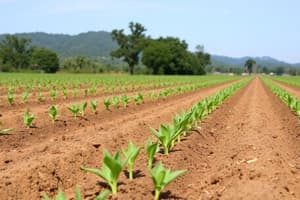Podcast
Questions and Answers
Which set of geographical factors MOST significantly influences the global distribution of agricultural crops?
Which set of geographical factors MOST significantly influences the global distribution of agricultural crops?
- Climate, soil composition, relief (terrain), and water availability. (correct)
- Globalisation, transportation networks, and international relations.
- Technological advancements, market demand, and government policies.
- Cultural practices, historical trade routes, and population density.
How do agricultural crops contribute to BOTH basic human needs and industrial development?
How do agricultural crops contribute to BOTH basic human needs and industrial development?
- Providing sustenance through food crops and raw materials for agro-based industries. (correct)
- Enhancing biodiversity in natural ecosystems and reducing carbon emissions.
- Generating renewable energy resources and improving water quality.
- Creating employment opportunities in urban centers and promoting international tourism.
If a region experiences prolonged drought and soil degradation, which of the following adaptations would BEST support continued agricultural production?
If a region experiences prolonged drought and soil degradation, which of the following adaptations would BEST support continued agricultural production?
- Introducing drought-resistant crop varieties and implementing water conservation techniques. (correct)
- Shifting cultivation practices with longer fallow periods.
- Expanding the area under cultivation to compensate for lower yields.
- Importing food crops from other regions to meet local demands.
What is a key distinction between food crops and non-food crops based on their primary use?
What is a key distinction between food crops and non-food crops based on their primary use?
Which example BEST illustrates the relationship between climate, crop type, and agro-based industry?
Which example BEST illustrates the relationship between climate, crop type, and agro-based industry?
Flashcards
Food Crops
Food Crops
Crops grown for human consumption or animal feed.
Non-Food Crops
Non-Food Crops
Crops grown for industrial or commercial purposes, not primarily for food.
Cereals
Cereals
Seeds of cultivated grasses used as a staple food source.
Pulses
Pulses
Signup and view all the flashcards
Oilseeds
Oilseeds
Signup and view all the flashcards
Study Notes
- Climate, soil, relief, and water availability vary globally, leading to different crops suited to various environmental conditions.
- Agriculture provides basic necessities, including food and clothing.
- Crops are grown as food, beverages, or fibre crops.
- Agro-based industries have been promoted by crops.
- Agricultural crops are required as raw materials for these industries.
- Climate determines the type of crop that can be grown.
- The type and level of farming also influence the quality and quantity of production.
Rice
- It is a major cereal crop and a staple food.
Types of Agricultural Crops
- Agricultural crops can be categorized as food crops and non-food crops.
Food Crops
- Cereals: rice, wheat, maize, millet.
- Pulses: gram, beans, urad, arhar.
- Oilseeds: mustard, linseeds.
- Beverages: tea, coffee, cocoa.
Non-Food Crops
- Fibre Crops: cotton, jute, hemp.
- Others: rubber, tobacco.
Studying That Suits You
Use AI to generate personalized quizzes and flashcards to suit your learning preferences.




